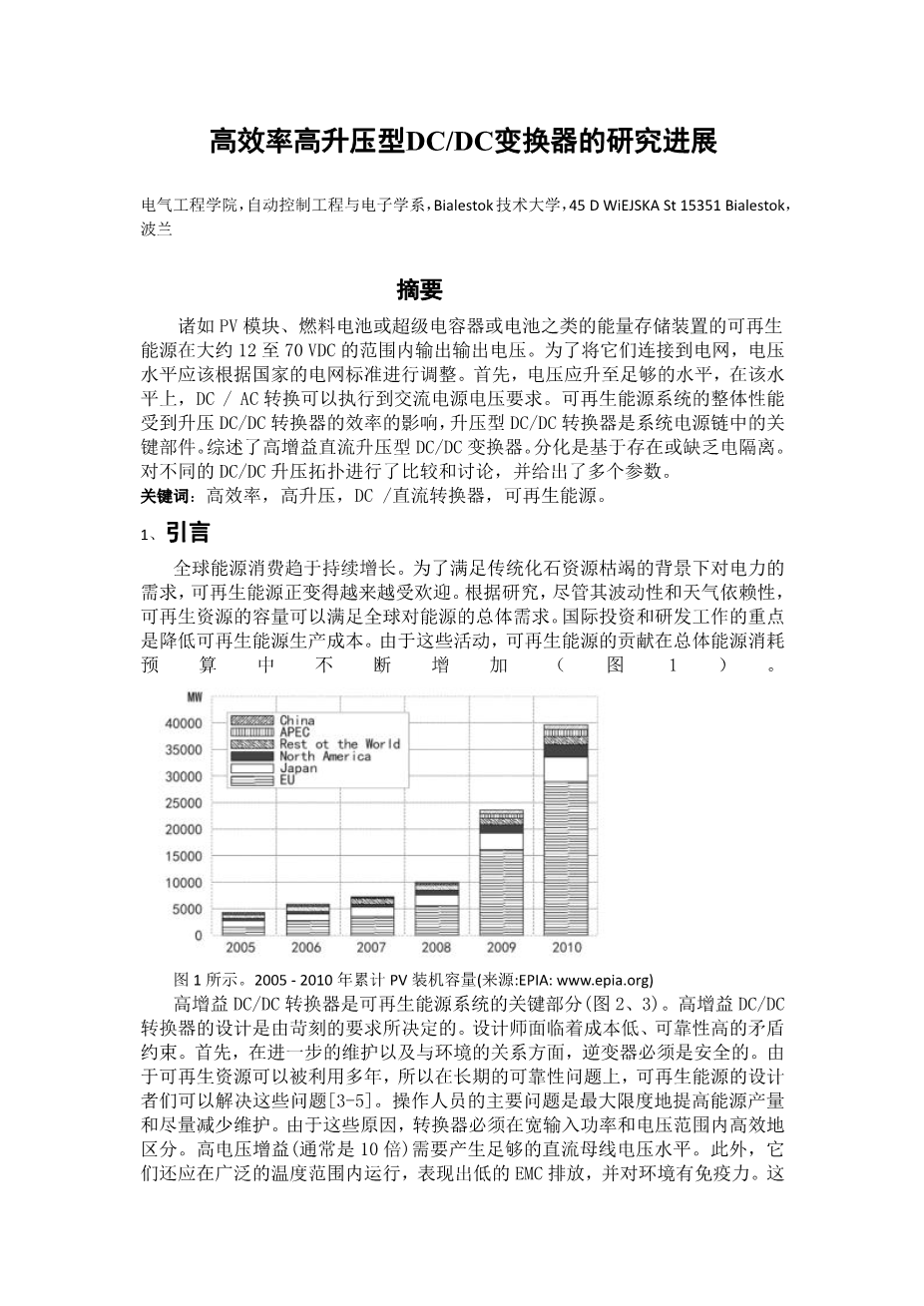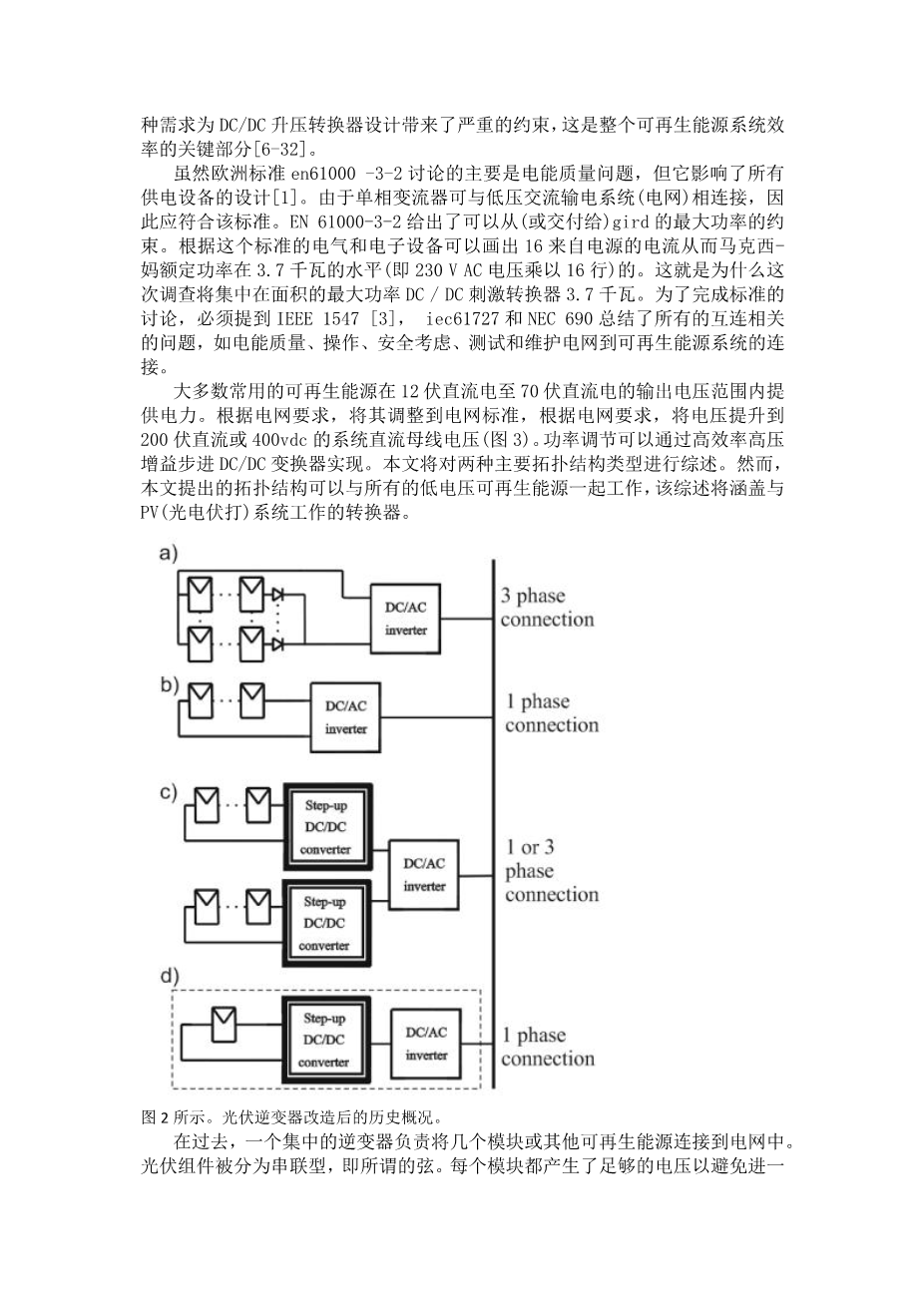High efficiency high step-up DC/DC converters – a review
A. TOMASZUK∗ and A. KRUPA
Faculty of Electrical Engineering, Department of Automatic ControlEngineering and Electronics, Bialystok University of Technology, 45d Wiejska St. 15-351 Bialystok, Poland
Abstract. The renewable energy sources such as PV modules, fuel cells or energy storage devices such as super capacitors or batteries deliver output voltage at the range of around 12 to 70 VDC. In order to connect them to the grid the voltage level should be adjusted according to the electrical network standards in the countries. First of all the voltage should be stepped up to sufficient level at which the DC/AC conversion can be performed to AC mains voltage requirements. Overall performance of the renewable energy system is then affected by the efficiency of step-up DC/DC converters, which are the key parts in the system power chain. This review is focused on high efficiency step-up DC/DC converters with high voltage gain. The differentiation is based on the presence or lack of galvanic isolation. A comparison and discussion of different DC/DC step-up topologies will be performed across number of parameters and presented in this paper.
Key words: high efficiency, high step-up, DC/DC converter, renewable energy.
Introduction
Global energy consumption tends to grow continuously. To satisfy the demand for electric power against a background of the depletion of conventional, fossil resources the renewable energy sources are becoming more popular [1, 2]. Accord- ing to the researches [3, 4] despite its fluctuating nature and weather dependency the capacity of renewable resources can satisfy overall global demand for energy. The international investments and Ramp;D efforts are focused on reduction of re- newable energy production cost. Thanks to these activities the contribution of renewable energy continuously increases in overall energy consumption budgets (Fig. 1), [2].
Fig. 1. Cumulative PV installed capacity 2005 to 2010 (source: EPIA: www.epia.org)
High gain DC/DC converters are the key part of renew- able energy systems (Figs. 2, 3). The designing of high gain DC/DC converters is imposed by severe demands. Designers face contradictory constraints such as low cost and high relia- bility. First of all the inverters must be safe in terms of further maintenance as well as in relation to the environment. Since the renewable sources can be utilized for many years the con- verter designers cope with long time reliability issues [3–5]. The main problem for the operator is to maximize the energy yield and to minimize the maintenance. For these reasons the converters must be distinguished by high efficiency over wide input power and voltage range. High voltage gain (usually ten- fold) is required to produce sufficient DC bus voltage level. Additionally they should operate at wide temperature range expressing low EMC emission and be immune to environ- mental conditions. Such demands create severe constraints for DC/DC boost converter designing which are key parts in terms of efficiency of overall renewable energy systems [6–32].
Although the European standard EN 61000-3-2 discuss- es mainly the power quality issues, it influences designing of all power supply equipment [1]. Since single phase converter can be connected to low-voltage AC public mains distribution system (grid) it should be complied with that standard. The EN 61000-3-2 gives the constraints as to the maximum power which can be drawn from (or delivered to) the gird. Accord- ing to that standard the electric and electronic equipment can draw up to 16 A of current from the mains thus its maxi- mum rated power is at the level of 3.7 kW (i.e. 230 V of AC line voltage times 16 A). That is why this investigation will be focused on the area of DC/DC boost converters with the maximum power of 3.7 kW. To complete the standard discus- sion it has to be mentioned that IEEE 1547 [3], IEC 61727 and NEC 690 summarize all interconnection related issues, such as power quality, operation, safety considerations, test- ing, and maintenance of the grid to renewable energy system connection.
The majority of commonly used renewable energy sources deliver electric power at the output voltage range of 12 VDC to 70 VDC. To adjust it to the electric grid standards that voltage should be boosted to the system DC Bus voltage ofaround 200 VDC or 400 VDC depending on the grid require- ments (Fig. 3). Power conditioning can be accomplished by high efficiency high voltage gain step-up DC/DC converters. In this article two major topology types of step-up converters will be reviewed. However topologies presented in this paper can work with all low voltage renewable energy sources the review will cover the converters working with PV (photovolta- ic) systems.
Fig. 2. Historical overview of PV inverters after Ref.28
In the past one centralized inverter was responsible for connecting several modules or other renewable energy sources into the grid. The PV modules were divided into series con- nections, so called strings. Each module was generating high voltage sufficient to avoid further amplification Fig. 2a.
At the moment, string technology is dominating. Central- ized technology has been replaced and two standards are cur- rently used. The first technology comprises separate strings attached to one DC/AC inverter connected directly to the grid Fig. 2b. The sub-type of string technology is called multi- string technology Fig. 2c with separate DC/DC converter that supports a panel or panel structure. Then DC/DC converter is attached to the DC/AC inverter which is coupled to the grid (1-or 3-phase).
The string inverter is nothing but the reduced version of the technology seen on (Fig. 2a)
剩余内容已隐藏,支付完成后下载完整资料


英语译文共 14 页,剩余内容已隐藏,支付完成后下载完整资料
资料编号:[467453],资料为PDF文档或Word文档,PDF文档可免费转换为Word


